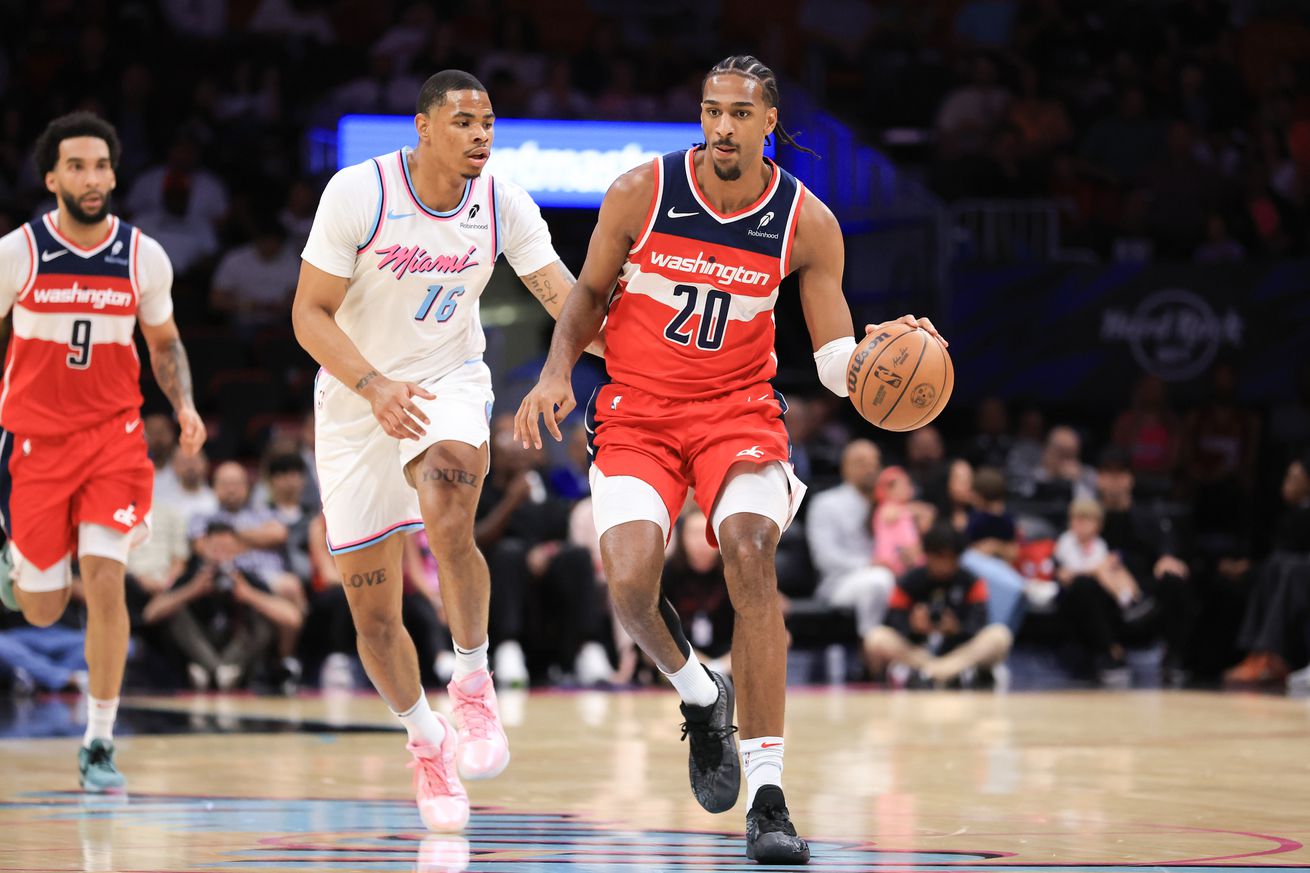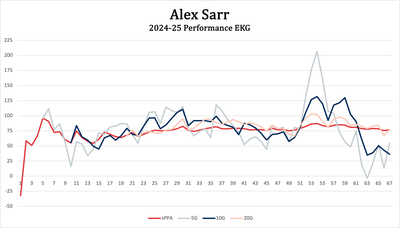
Stats, analysis, commentary, and a performance EKG.
If you emerged from Alex Sarr’s rookie season with a vague (or even specific) sense of disappointment, I’m not going to say you’re wrong.
He was a mess at times. His offensive efficiency was 16.5 points per 100 possessions below average. He didn’t excel on the boards. Just 17% of the seven-footer’s field goal attempts were from within the restricted area. An epically bad team was worse when he was on the floor. His Player Production Average (PPA — my all-around rating system) was a below-average 77.
What I will suggest is to consider one key piece of information that’s super important when considering the context of his performance: he was just 19 years old. Washington’s season ended on April 13. He turned 20 two days ago.
Let’s unpack a bit. If you want stay worried, stay focused on that 98 (by my calculation) or 99 (according to Basketball-Reference’s method) offensive rating (points produced per 100 individual possessions). That ranks just 82nd among 125 teenaged rookies in NBA history, according to the B-R database.
There are some gaudy names who posted similar efficiency as teenaged rookies (LeBron James had a 99 ortg. Giannis Antetokounmpo was basically tied with Sarr. Kevin Durant managed a 100.) but don’t get too excited. The league’s offensive environment was different.
For example, LeBron’s ortg was about three points per 100 possessions below league average in his rookie season. Durant and Giannis were each about -8. Sarr was about -16.
That’s not entirely discouraging. High efficiency teenaged rookies tended to be rim-running bigs or players who played fewer minutes and were lower usage. The Wizards envision Sarr as a mobile big man who can stretch the floor with three-point shooting, and he was encouraged to explore the studio space despite some (at times) cringey results.
I’m not saying efficiency for a teenager doesn’t matter — it does. What seems to matter more is usage. In my reading of the available data, it appears that a kid attempting to make plays is a more important predictor of future success than succeeding.
Now, this is hardly linear. The top 10 in teenage rookies usage includes guys like Luka Doncic, Zion Williamson, Kyrie Irving, Carmelo Anthony, Lebron James, Kevin Durant, Anthony Edwards, and LaMelo Ball. It also includes Cam Whitmore and Scoot Henderson. Landing 11th: Emmanuel Mudiay.
Among this group, Sarr ranks 25th in usage — about the same level as players like RJ Barrett, Devin Booker, Jaren Jackson Jr., and Andrew Wiggins, and higher than names like Josh Giddey, Bradley Beal, Alperen Sengun, Zach LaVine, Jamal Murray, Jayson Tatum, Tracy McGrady, Jrue Holiday, Chris Bosh, Tony Parker, Kevin Garnett, Dwight Howard, and Giannis.
In other words, when looking at teenage rookies, Sarr was relatively high in “trying to make plays on offense” and relatively low in “succeeding at making plays on offense”. Again, my reading of the data suggests trying is more important at this early stage in a player’s career.
Through the years, I’ve written and said a number of times that when determining a player’s value, it’s critical to consider the totality of what he or she does on the floor. Basketball isn’t like baseball or football where players can specialize in specific situations. You have take the whole player, so it’s important to evaluate his all-around performance.
This brings me to Sarr’s PPA and what I call a performance EKG. PPA is my all-around rating metric, which rewards players for things they do to help a team win (making shots from the floor, getting to the free throw line, playmaking for teammates, rebounding, defending) and debits them for things that hurt (missing shots, committing turnovers, excessive fouling, poor defense). PPA includes accounting for role. In PPA, average is 100, higher is better, and replacement level is 45.
Sarr’s 77 PPA indicates a below-average season this season. Worth mention: it’s a bit above average for teenage rookies (average for that group is about 70).
At no point during the season did Sarr’s rolling full-season PPA score crack average. The closest he got was a 96 just five games into the season. He had several five-game stretches that were better than average, including an inspiring 207 over a five-game span in March. He had 10-game stints that topped average in January and again in March, and 20-game periods that were a bit better than average in March.
As the chart below indicates, there was no major improvement trend. That’s normal and not worrisome. Most players improve from offseason work. The ekg lines indicate a decent start, some struggles, a nice stretch of quality play in March, and then a cratering at the end of the year.

Kevin Broom
sPPA (red line) = rolling full-season PPA calculated after each game
5G (gray line) = PPA from the previous five games calculated after each game
10G (blue line) = PPA from the previous 10 games calculated after each game
20G (pink line) = PPA from the previous 20 games calculated after each game
Despite the inefficiency and some other flaws in his game that must be addressed, Sarr’s overall performance at his age should be viewed as encouraging. He’ll have to put in the work, but at just 19 years old, he has a lot of runway to launch a great career.
I’ll close with this: I have a spreadsheet that estimates a player’s career trajectory based on his PPA performance at a given age and applying average improvement rates to his future years. Here’s what that forecaster says about Sarr:
- Age 19 — 77 (this is Sarr’s PPA this season)
- 20 — 85 (modest improvement and still a bit below average)
- 21 — 123 (bigger jump in performance and better than average)
- 22 — 160 (The leap — this is All-Star level performance)
- 23 — 184 (This would be at least edging into All-NBA discussions)
- 24 — 197 (Probably making an All-NBA team)
- 25 — 203 (All-NBA first or second team; possible a fringe MVP candidate)
- 26 — 205
- 27 — 203
- 28 — 199
- 29 — 186
- 30 — 171
- 31 — 154
- 32 — 136
- 33 — 113
In other words, if Sarr follows a “normal” career arc (improving or declining by the historical average each season), he’d post 13 seasons that rated average or better, 9-10 All-Star level seasons, 7 years that would at least be in the All-NBA conversation, and perhaps 2-3 seasons at the level of a fringe MVP candidate.
This is not a guarantee, of course. But if he does the work, the Wizards may have emerged from the 2024-25 season with one of their building blocks of the future.
